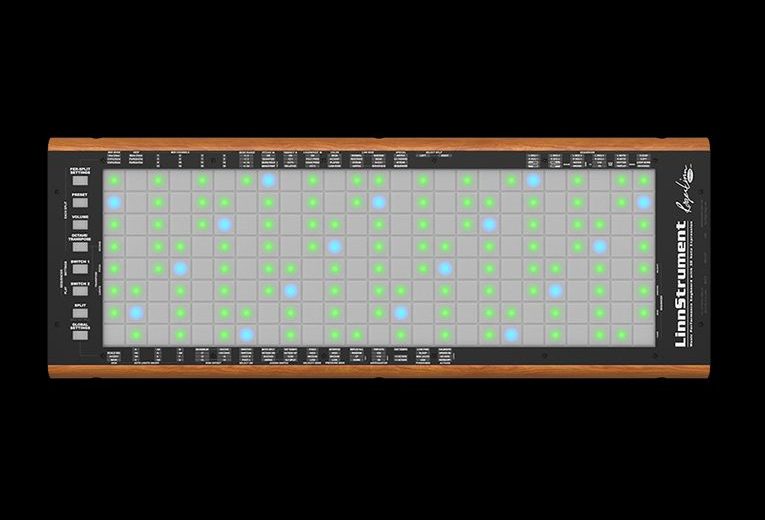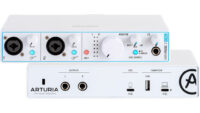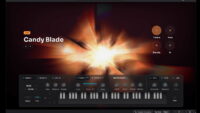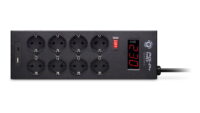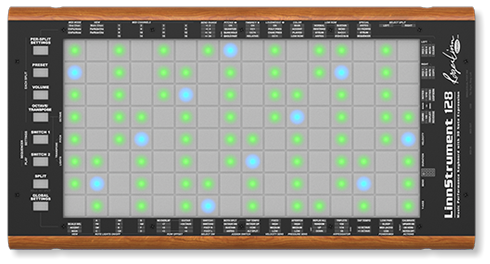
Expressive Music Controller
Meet LinnStrument, an expressive MIDI controller for musical performance. Unlike the simple on/off switches of a standard MIDI keyboard, LinnStrument’s backlit note pads sense each finger’s subtle movements in five ways, enabling musical performance expression rivaling that of fine acoustic instruments.
Five Types of Polyphonic Touch Sensing
LinnStrument’s patented touch-sensing technology permits you to slide in pitch directly from one note to another, tilt your finger forward/backward for subtle timbral variation, or vary note loudness with pressure or velocity, all sensitive to very light touches.
How are the notes arranged?
Why not a piano note arrangement?
The piano’s note arrangement works well for piano music, but its uneven pitch intervals and rear-positioned black keys make it ill-suited for performing natural pitch bends and slides, an important element of expressive performance.
Stringed instruments don’t have this problem because the semitones are uniformly spaced.
So LinnStrument’s notes are arranged as on any stringed instrument. Each row is a series of consecutive semitones, so bends and pitch slides are simple and intuitive: play a note, slide left or right to the destination note, then wiggle it for vibrato.
You can tune the rows like a guitar, violin or however you wish. By default they are tuned in musical fourths (five semitones), like a bass guitar with 8 strings. This note arrangement is called the 4ths String Layout and is fast becoming a new standard for expressive musical control, used in Ableton Push, Roli’s LightPad Block, a variety of iPad apps and now over 2200 LinnStruments sold.
To make it easy to find the right notes, the scale notes are lit, with all the C note pads lit in a different color and having a Braille-size bump for tactile feedback. Alternatively, you can light any scale and in any of 10 colors.
Works with every MIDI synth.
MPE-compatible
LinnStrument sends standard MIDI messages over its USB or MIDI output jacks, and is configured by default to work out-of-the-box over a single MIDI channel for compatibility with every MIDI sound generator in existence, but with the advantages over a MIDI keyboard of performed vibrato, note-to-note pitch slides, polyphonic pressure sensing, and forward/backward touch control. And LinnStrument gets around MIDI’s one-channel Pitch Bend limitations by automatically quantizing polyphonic pitch slides to semitones, while leaving solo pitch slides continuous.
To also perform fully polyphonic pitch slides and Y-axis gestures, you’ll need a synth that’s compatible with MPE (MIDI Polyphonic Expression), a new MIDI standard that uses a separate MIDI channel for each touch. It’s already supported in a long list of major software instruments. We even include free sounds files for Apple’s MainStage and Logic, plus a free license for Bitwig 8-Track, all of which support MPE in their built-in synths.
Extraordinarily Versatile
Step Sequencer – Use LinnStrument’s RGB note pads as a powerful 2-track step sequencer with per-note velocity/duration/bend/y-axis values, any time signature, independent track step sizes and loop lengths, scales/drums/notes views, reverse play, live play while sequence plays, swing timing and more.
Expressive Swing Arpeggiator – LinnStrument’s built-in Arpeggiator responds to all dimensions of movement for entirely new ways of beat-synced play. The Replay All mode creates chordal rhythms merely by varying chord pressure, and makes LinnStrument the world’s only MPE beatbox.
Split Keyboard / Strum / CC Faders- You can split the keyboard to play two different sounds, and adjust the split point as you like. You can use one split to strum notes fingered on the other split as like a guitar. Or use either split as eight horizontal Control Change Faders to adjust 8 sound parameters in real time as you play.
Low Row – The lowest row of note pads can be reassigned to act as a Sustain Pedal, a Modulation or Bend strip, to momentarily enable the Arpeggiator (sliding your thumb to vary its rate), to restrike a fingered chord, or even as a 3D control strip, modulating three parameters at once.
Play on a table or standing – you can play it on a table like a keyboard, but at only 5 pounds (large model) and 1″ thin, you can also use the included guitar strap pins to play it standing up like a guitar.
Single or Dual Foot Switch Input – Connect a standard single or dual foot switch for foot control of sustain, Arpeggiator, octaves, Tap Tempo, Control Change messages and more.
All Settings on front panel / Open Source software – All of LinnStrument’s settings are available on the front panel so there’s no need to fumble with computer editing software. And even with all of LinnStrument’s versatility, we didn’t want to limit how people would use it. So we released the software as open source, allowing you to customize everything.
Join the Revolution
There’s a revolution brewing. People are starting to understand how limiting it is to play music with on/off switches. Once you’ve played LinnStrument, it’s very difficult to go back. We (Roger and LinnStrument software creator Geert Bevin) invite you to join the revolution.
LinnStrument … IDR 25.186.000 (200 note pads, 5 octaves)
LinnStrument 128 … IDR 16.786.000 (128 note pads, 4 octaves)

